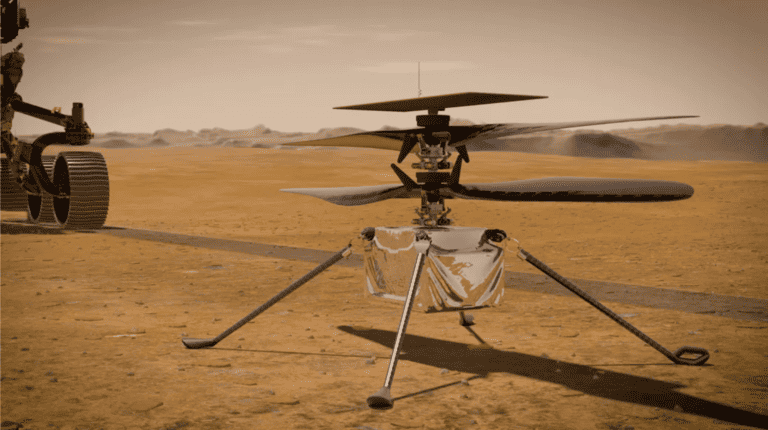NASA’s Ingenuity Mars Helicopter (Image credit: NASA/JPL-Caltech)
Exploring Dual Realms: Earth and Mars Trials
NASA has initiated a groundbreaking venture, utilizing Earth and Mars as experimental canvases for advancing aircraft design. This innovative initiative underscores NASA’s commitment to extensive trials on both terrestrial and Martian landscapes. A significant breakthrough unfolded at NASA’s Jet Propulsion Laboratory (JPL) in Southern California, where an avant-garde rotor designed for potential deployment in Mars helicopters underwent rigorous testing, achieving rotational speeds approaching supersonic levels (0.95 Mach).
Simultaneously, on Mars, the Ingenuity Mars helicopter, an engineering marvel developed by JPL, has been rewriting records for altitude and airspeed during experimental flights. Originally introduced in 2021 as a technology demonstration showcasing the feasibility of flight on Mars, Ingenuity is now exploring the prospects of aerial reconnaissance for future planetary missions.
Rotor Testing and Challenges
In the realm of advanced rotor testing, NASA is scrutinizing cutting-edge carbon fiber rotor blades tailored for larger and more capable Mars helicopters. These blades, slightly exceeding four inches (over 10 centimeters) in length compared to those on the Ingenuity helicopter, exhibit augmented strength and a distinct design. Nevertheless, NASA’s statement underscores the formidable challenge of managing turbulence-induced vibrations as the rotor blades approach supersonic speeds.
Engineers employed JPL’s space simulator, renowned for testing spacecraft such as Surveyor, Voyager, and Cassini, to simulate Martian conditions on Earth. Over a three-week span in September, the team meticulously monitored sensors, meters, and cameras as the advanced rotor blades underwent multiple runs, reaching speeds of up to 3,500 revolutions per minute—750 revolutions per minute faster than the Ingenuity blades. The success of these trials confirmed the readiness of these more efficient blades for actual flight.
Ingenuity’s Impressive Flight Record
Contrary to the initial expectation of merely five flights, the Ingenuity helicopter has surpassed predictions, completing an impressive tally of 66 flights over the past two-and-a-half years, extending its initially planned 30-day mission by an astonishing 32 times. Recent achievements include doubling maximum airspeed and altitude, increased rates of vertical and horizontal acceleration, and enhanced landing capabilities.
Despite constraints related to energy and motor temperature, Ingenuity has played a pivotal role in providing valuable data for future mission designers. Navigating challenges associated with flight speed, the team has balanced the need for covering more ground with the limitations of the onboard navigation system, which relies on a camera for identifying rocks and surface features.
Recent flights, such as Flight 61 reaching a new altitude record of 78.7 feet (24 meters) to study Martian wind patterns and Flight 62 setting a speed record of 22.3 mph (10 meters per second) while scouting locations for the Perseverance rover’s science team, highlight the versatility of the helicopter and its significant contribution to scientific exploration.
Innovative Landing Experiments and Future Tests
Noteworthy experiments with landing speeds have demonstrated the helicopter’s ability to safely land at speeds 25 percent slower than initially planned, potentially paving the way for lighter landing gear in future designs. Engineers eagerly anticipate the helicopter’s upcoming tests in December, where two high-speed flights, each with unique pitch-and-roll angles, are poised to provide vital data for refining aero-mechanical models of rotorcraft behavior on Mars, as emphasized by Travis Brown, Ingenuity’s chief engineer at JPL.
References
Malayil, Jijo 2023, NASA trials next-gen aircraft designs on Earth and Mars, a first, Interesting Engineering, viewed 28th November 2023, https://interestingengineering.com/innovation/nasa-trials-next-gen-aircraft-designs-on-earth-and-mars-a-first
NASA, 2023, 6 things to know about NASA’s ingenuity Mars Helicopter, viewed 28th November 2023, https://www.nasa.gov/solar-system/6-things-to-know-about-nasas-ingenuity-mars-helicopter/




















